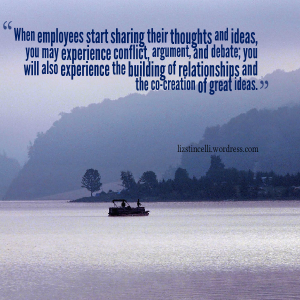“Things do not change; we change.”—Henry David Thoreau
By Elizabeth Stincelli, DM
Inspiring Change
Henry David Thoreau’s words serve as a strong reminder that only through changing ourselves do we change our circumstances. Just as leaders are not born, but are built by day-to-day behaviors, so are the changes in your organization. When you develop and encourage your employees, they become the change that you desire for your organization. The attention you give, the support you provide, and the example that you set shines as a beacon, inspiring change, one person at a time.
So, how can you inspire others to change?
Vision
The Dalai Lama said, “In order to carry a positive action we must develop here a positive vision.” If you want to inspire in others the desire to change as individuals, in order to spur change in your organization, you must put forth a strong, vivid vision that they can buy into. Everyone needs a clear understanding of where the organization is headed and how their activities contribute. You must create a sense of inclusion where every employee understands the role they play in working towards a worthwhile, positive vision.
Engagement
Rupert Murdoch believes, “In motivating people, you’ve got to engage their minds and their hearts.” You can’t bully or manipulate people into lasting change. They must follow you through thick and thin because they want to, because they are engaged, and they believe in you. Help your employees find their calling, engage them in using their talents for the good of the organization. Make their work meaningful. Build trust, help them develop their skills, and then give them control over their own work tasks. Help them succeed and then give credit for a job well done. When you invest in and engage employees, they become better and, as they become better, your organization becomes stronger.
Opportunity
Albert Einstein told us, “All that is valuable in human society depends upon the opportunity for development accorded the individual.” Only when you give others the opportunity to develop and grow as individuals will they become more valuable. And, only through increasing the value of individuals, can you bring about true and lasting change. Give employees the opportunity to be involved. Encourage them to dig deeper and challenge the status quo. As a leader, give of your time, sharing your knowledge and experience with employees to help them to grow and become the best they can be.
One Person at a Time
Change is built and sustained through everyday action, one person at a time. When you invest in helping your employees become the best they can be, you will build a strong capacity for lasting change. Put forth a compelling, positive vision that each employee can be part of. Engage them in their work; provide them the skills and resources necessary and then give them control. Open the doors of opportunity so employees can continue to grow. If you want change, you must inspire it, one person at a time.
© 2015 Elizabeth Stincelli
Elizabeth Stincelli is passionate about recognizing and inspiring the leader in each of us. She is the CEO of Stincelli Advisors where she focuses on helping organizations engage employees and improve organizational culture. Elizabeth holds a Doctor of Management degree with an emphasis on organizational leadership.
Learn more about Elizabeth by visiting her website, stincelliadvisors.com and connect with her on Twitter @infinitestin, Google+, and LinkedIn. You can contact her by email at stincelliadvisors@gmail.com.










